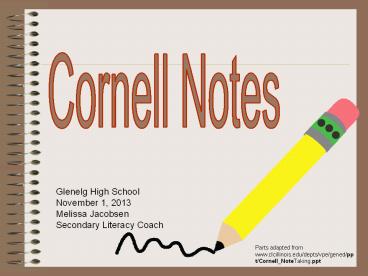Cornell Notes - PowerPoint PPT Presentation
1 / 23
Title:
Cornell Notes
Description:
Title: PowerPoint Presentation Author: CIS Last modified by. Created Date: 7/26/2001 6:06:01 PM Document presentation format: On-screen Show (4:3) – PowerPoint PPT presentation
Number of Views:374
Avg rating:3.0/5.0
Title: Cornell Notes
1
Cornell Notes
Glenelg High School November 1, 2013 Melissa
Jacobsen Secondary Literacy Coach
Parts adapted from www.clcillinois.edu/depts/vpe/
gened/ppt/Cornell_NoteTaking.ppt?
2
Outcomes
- Participants will
- Develop an understanding of the Cornell Note-
taking method - Understand scaffolding and extension techniques
related to Cornell Notes
3
Why Cornell Notes?
- Cornell Notes is one tool, it is not the only
tool - Some teacher may assume students know how to take
notes - By teaching students one method of note taking,
they have a foundation - Students see commonality among disciplines
4
Cornell Notes
- Help students remember what is said in class
- Help students prepare for tests outside the class
- Builds independence
5
Cornell Notes
- Help students to organize and process data and
information - Visually makes sense to students
- Can support Summarizing SLOs
- Writing is a great tool for learning!
6
What is looks like
Topic
Heading
Main ideas/ questions
Notes
Summary of notes- 3-4 sentences at bottom
http//www.youtube.com/watch?v1iolZMTGUpw
7
Economics
8
Math
9
ART
10
Health
11
Anthropods
Biology
12
Physics
13
English
- Non-Fiction- note taking on facts, main ideas in
background information, rhetoric in a speech - Fiction- Character analysis, sensory details,
quote analysis, scaffolding towards a
text-dependent question
14
(No Transcript)
15
Comparing Texts
Central Question What can passenger lists tell
us about who settled in the New World and where
they settled?
16
(No Transcript)
17
Rewriting notes in Cornell Format
- Students may take guided notes, fill in an
outline, or other note taking format that you
might already use - Students re-copy their notes in the Cornell
Format for homework or as an extension creating
their own questions or main - ideas
- Automatic review/ Studentt Created Study Guide
- Kinesthetic learning
- Can edit, look-up words
- Prompts higher-level question- Students can come
up with questions to use as review in class the
next day
18
Scaffolding Cornell Notes
- Model how to use Cornell Notes
- Provide templates
- Provide all main ideas and questions for students
- Provide 2 or 3 main ideas or questions and ask
students to come up with 2 or 4 on their own
19
(No Transcript)
20
After Your Notes are Complete
- Synthesize and make connections between note
sheets - Highlight, circle and underline most important
information or details - Cross out unimportant information
- Use notes for further studying
21
Revision Checklist
22
Remember
- There are many ways to use Cornell Notes
- Cornell Notes can be used for both non-fiction
and fiction - Teachers should model note taking
- Scaffold students toward independence
23
Literacy Open Office Hours
- Wednesday, Nov. 6- Media Center












![download⚡[PDF]❤ Cornell Notes Notebook: Marble Notebook (2), Note Taking Composition Notebook F PowerPoint PPT Presentation](https://s3.amazonaws.com/images.powershow.com/10041740.th0.jpg?_=202405290712)


















